The Khajuraho Group of Monuments is a set of Hindu and Jain temples in Madhya Pradesh, India. In particular, they are one of the many UNESCO-accredited World Heritage Sites. They were recognized for their artistic architecture and a mix of perfect sculptures, in keeping with the heritage and culture of India.
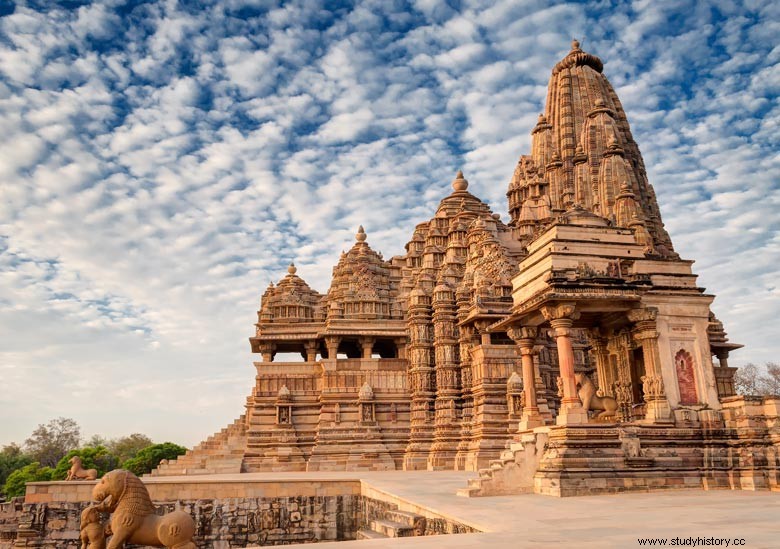
India is a land of architectural wonders. Starting from the World Wonder Taj Mahal to the Tanjore Temple, the intricacies of design and materials used, the command of craftsmanship and the technical details involved in building such massive structures have left all historians and research experts in awe.
In fact, most of what we see today is the remains of invasions and other environmental damage. Let's uncover the history of the series of temples in Khajuraho.
Who built the temple?
The Chandella dynasty that ruled central India between the 10th and 12th centuries (900 CE - 1130 CE) built the structures. This ancient city was the capital of their kingdom, the Bundelkhand. Furthermore, they were believers and followers of Shaivism, Vaishnavism and Jainism. Therefore, almost a third of the total construction was contributed to each of the communities.
The legends behind the Khajuraho temples
Stories behind the name "Khajuraho"
Khajuraho - is derived from the Sanskrit word Khajuravaahaka, meaning "date palm holder", "a bearing date palm". Based on local legends, it can be assumed that the temples were built with two golden date palms as the gates. It does not exist today. Another theory states that King Chandravarman, who built the temple, planted palm trees on all four sides of the temple. It is also believed that the word alternatively means "scorpion bearer", another name for Lord Shiva, a Hindu deity. Thus, these temples were identified by their relationship to palm trees, according to one of the speculations.
Stories behind building temples
Would you be surprised if I said that descendants of the moon god were responsible for raising this temple? Maybe not, because the moon is always associated with romance and love.
According to mythological stories, a beautiful woman named Hemvati bathed in the pool of Benaras. The moon god fell over her beauty and fell for her, and she eventually gave birth to a boy. He was named "Chandravarma" and was born before their wedding. Then, for fear of negligence and bad name from society, she cursed the moon god. But he prophesied that the child would grow up to be a king.
It happened, and he founded the Chandella dynasty. Then, after Hemvati, his mother, died, she appeared in his dreams. She asked him to build a temple depicting human love, passion and life. That was when he decided to build the Khajuraho temples.
The temple is present in the Vindhya mountain range. According to a legendary Hindu deity Shiva and others like to visit the hill formation in Kalinjar, where the center is Khajuraho, which has hills and rivers. That is why temples are built in the place where the gods love to come, live or pray.
Theories about the sculptures
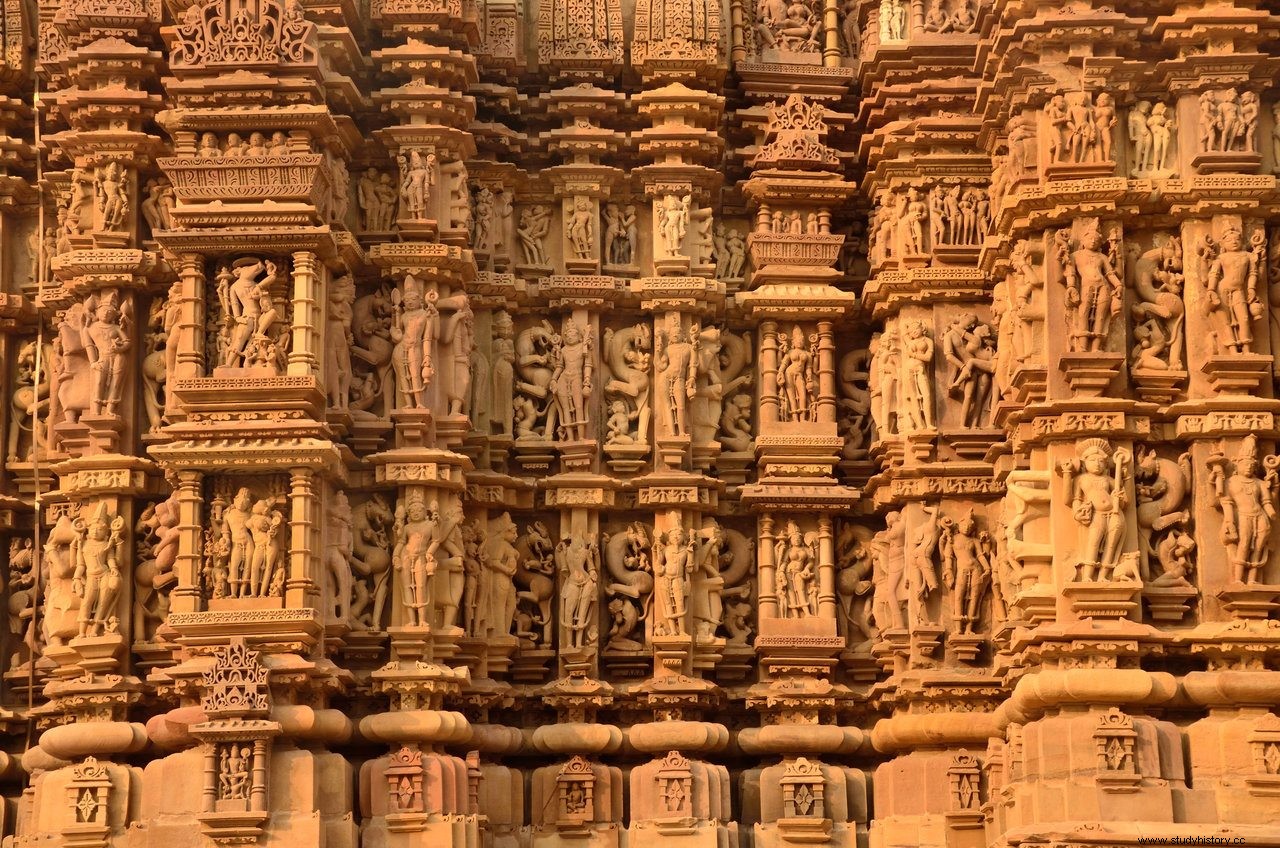
The temple walls display a variety of motifs of sculptures ranging from gods to animals to mythical creatures. The carvings of mithuns or couples in love and other mythical creatures representing lust and erotic feelings, and are said to bring "good luck". Some say that they served as a medium for sex education in the past, for people who chose to observe celibacy in life. Others say that the Mithuns are only carved outside the temple sanctuary, so that people learn to leave such thoughts of love and desire outside the sanctuary before entering the temple. They believe that is why such sculptures are not carved inside the temple.
The carvings are also known to reflect the four life goals of Hinduism, namely Dharma, Kama, Artha and Moksha. Mithunas are also seen as a reflection of the union of Shiva and Shakthi - the life forces of Hinduism. The oldest of all existing temples is the Chausath Yogini Temple. It consists of 64 empty shrines today that are believed to have had yogis in each of them, controlling the physical and mental life balance of Khajuraho, who is charged with energy.
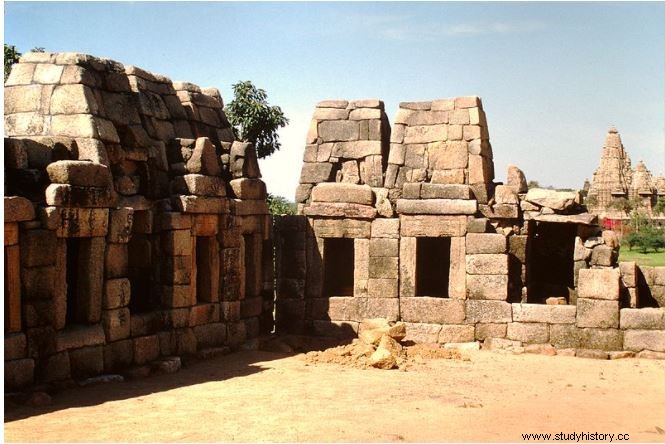
Today, a city near the temple is also named after these temples as Khajuraho. It is currently located in the Chhatarpur district of the Indian state named Madhya Pradesh.
Series of historical events related to the temple
The first mention of this temple in history is in 641 AD. by Xuanzang, a Chinese pilgrim who wrote about witnessing dozens of inactive Buddhist monasteries and dozens of Hindu temples with thousands of Brahmins worshiping. Then Abu Rahyan Al Biruni mentions in 1022 CE that he followed Muhmad from Ghazni to invade Kalinjar, but did not succeed and agreed on a peace agreement when the Hindu king offered ransom. And then Ibn Batuta in 1335 CE mentions visiting the Khajuraho temples as "Kajarra". Thus, there were about 85 temples spread over an area of 20 square kilometers in the 12th century.
Khajuraho -temples with complete data
| The name of the king | The name of the temple | Time Construction Period |
| Yashovarman | Lakshmana Temple | 939 CE |
| Dhanga | Vishvanatha Temple | 999 CE |
| Vidyadhara | Kandariya Mahadeva Temple | 1029 CE |
They were built in the Kalinjar region, 35 miles from the central city of Mahoba, which was also the capital of the Chandela dynasty. With many other surviving temples in Khajuraho, the table above shows some of those whose completion period and the name of the king's reign while the construction is clearly known. All of these temples were active with people who came to worship until the 12th century.
Central India was a region invaded by Muslim kings from the 13th century. Until the 18th century, there was a lot of destruction for Hindu temples. Therefore, many of those in Khajuraho were also desecrated. However, due to the distance and less accessibility to the location, at least 24% of the temples survived. They were rediscovered by local Hindus in the 1830s when they mentored a British surveyor, TSBrut.
Of the surviving temples, six are Shiva temples, eight are Vishnu temples, one is a Ganesh temple, one is a temple to the sun god and three are Jain Teerthankaras. But the remaining three temples are ruins and not completely intact.
Construction Details
Materials used
All the temples are built of sandstone with a granite foundation that is not visible. These are light sandstones imported from quarries in Panna, from the east bank of the Kane River. The stones are also held together due to gravity! Yes, there is no mortar, they were bonded with mortise and tenon joints. According to research experts, this type of construction requires a lot of precision.
Architecture style
The art and architecture of Hindu temples are defined in Shilpa Shastra. According to this, there are three main types of construction of a temple:Nagara or Northern atyle, Dravida or Southern style and Vesara or mixed style. Of these fall the Khajuraho group of Hindu temples in the Nagara architectural style, consisting of an Ardhamandapa / entrance leading to the main hall or Maha Mandapa , followed by Antarala , a narrow ante chamber that you enter through Garbagraha / sanctum. While the Jain temples are constructed as Teerthankaras .
Sculptures and carvings
The sculptures found in this architecture can be roughly classified into five types, as follows:
- Cult Images
- Parivara, Parsva and Avarana devatas - Guardian deities
- Apasaras / Sapna Sundaris and Surasundaris (Heavenly Virgos)
- Secular sculptures (people engaged in dance, agriculture, ceramics, make-up, etc.)
- Mythical creatures (Vyalas, Sardula and other animals)
There are 646 sculptures in total on the outside, of which only 10% carry an erotic theme. And there are about 226 sculptures in the interior. While the majority of the figures are less than a meter high, all Hindu deities such as Shiva, Vishnu, Ganesha, their guards and Mithunas are in the sculptures. Fine artistry can be a visual treat when you see the walls of these time-tested temples adorned with fine tantric carvings. Some of these sinuous carvings depict the intricate details of hair, fingernails and whatnot.
Meaning and significance of these sculptures
Chandeliers were known for their great interest in art and architecture. But nothing stopped them from pursuing different faiths as well. According to archaeologists, these three sets of temples were under construction and in use at the same time in the late 10th century. Of the surviving temples, 18 Hindu temples and 4 Jain temples are present. The Hindu temples have Shiva, Devi and Vishnu deities, which constitute Shaivism and Vaishnavism schools respectively. Most importantly, the proximity to these temples simply indicates the tolerance and acceptance they had towards other religions.
In 1986, UNESCO categorized the temples into three groups as follows:
Østgruppen
- Vamana
- Javari
- Brahma
- Ghantai
- Adinath
- Parsvanath
- Shantinath
Southern Group
- Duladeo
- Chaturbui
Western Group
- Chaushath Yogini
- Lalguan Maahadeva
- Matangesvara
- varah
- Lakshmana
- Kandariya Mahadev
- Devi Jagdamba
- Mahadeva
- Chitragupta
- Vishvanath
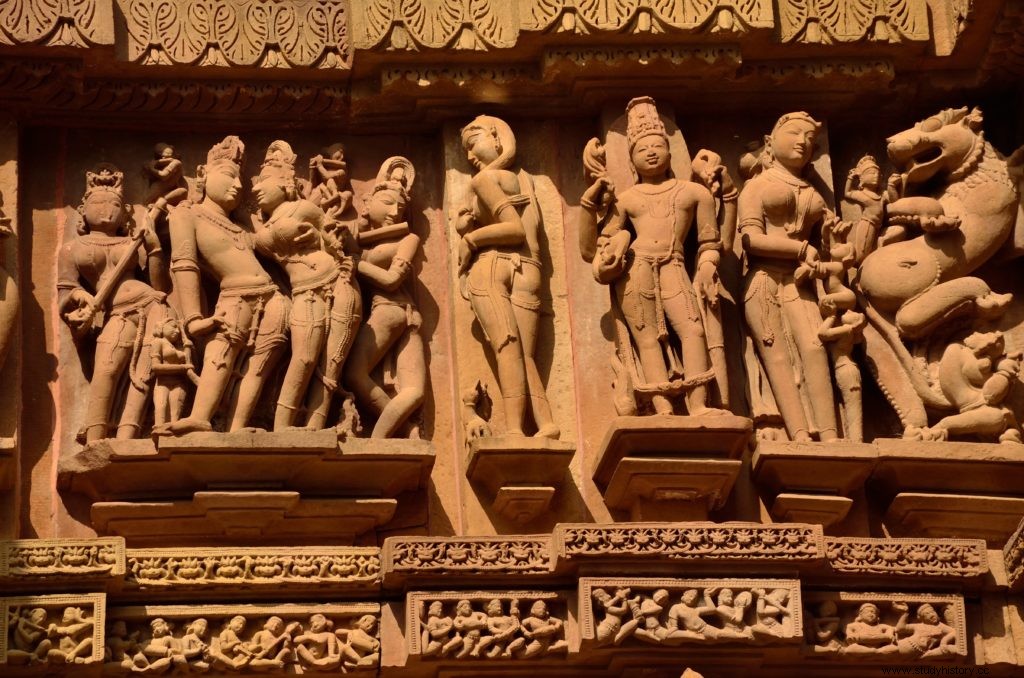
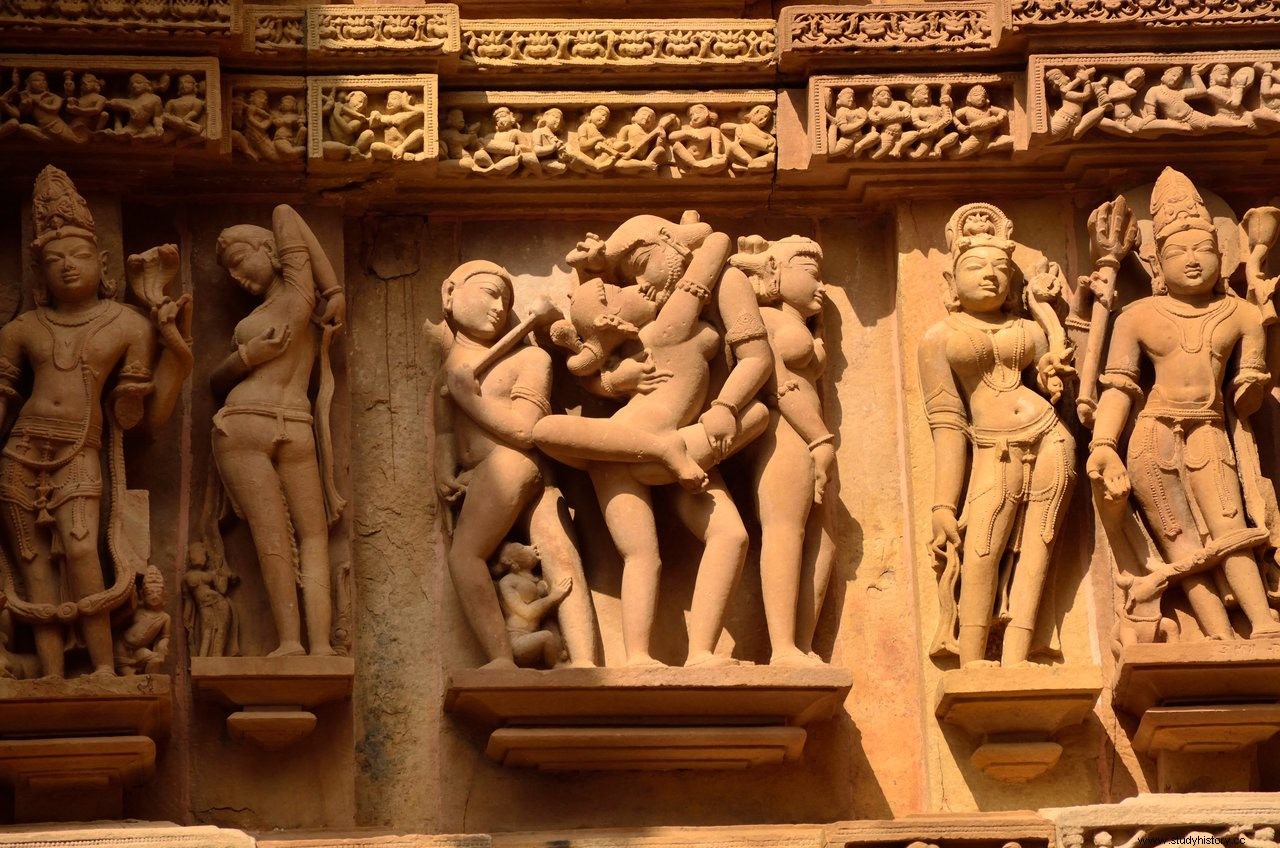
The ornate carvings directly represent various human occupations, such as agriculture, ceramics, musical instruments, warriors practicing, teachers teaching and so on. They also depict human activities such as applying makeup. Others are human life activities-farmers, women who dress up, put on make-up, passion for love.
As a combination of everything in human life, the monumental sculptures consist of only 10% of carvings and illustrations with erotic themes. Of these existing temples, the largest Shiva temple is the Khandarya Mahadeva temple, spread over 6,500 square meters, while the Shikara (Spire) rises to 116 feet and the largest Vaishnava temple is Chaturbuja and Ramachandra.
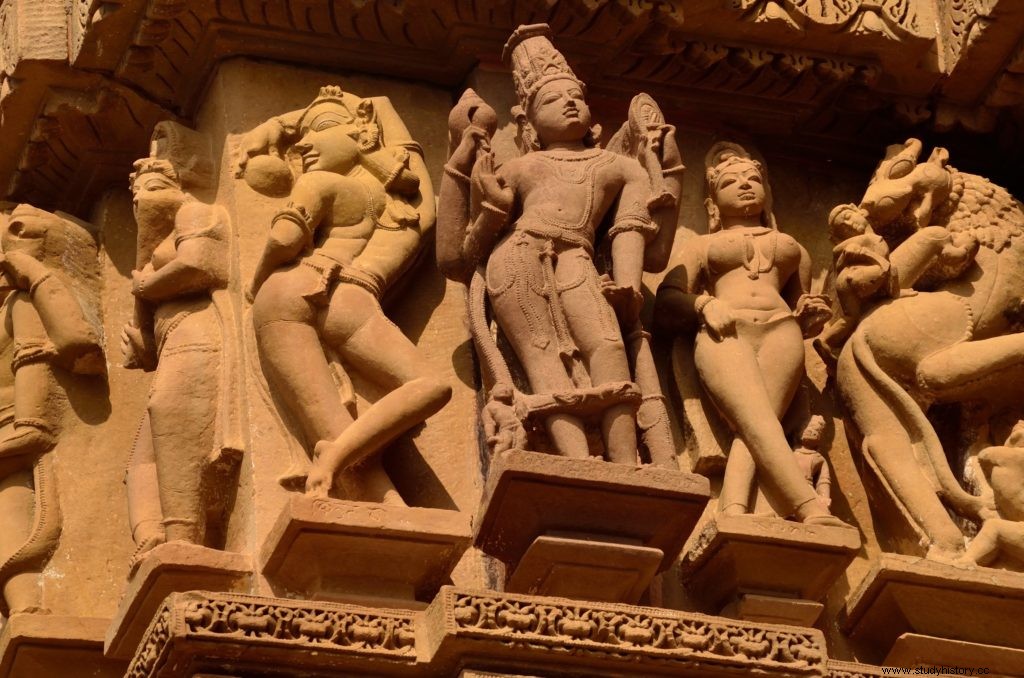
There are also nymphs that show human emotions and activities such as painting, holding a parrot, cuddling a baby, scratching their backs or undressing. But these are also found in the Hoysala temples. Interestingly, it has been found that some of the specific instructions in Kamasutra, an ancient Hindu book on love, were drawn by sculptors in Khajuraho.
Why should anyone visit the temple?
Most people today tend to assert themselves as modern and far-sighted people. But the reality is that our ancestors may have been more modern than we are today. Some striking similarities in the construction of these temples and the Great Pyramid of Giza itself are an example of raising this doubt. When we continue to talk about sex education becoming legal and being added to the curriculum, this part of human life with "love creation" was considered sacred, important and was treated very much like any other part of human emotions / activities. Unlike other temples, these temples tell a completely different story.
The purpose of building it
This is evident from the sculptures of these temples and the Kamasutra book written about this facet of human life. Creation is considered godly. Only God can be the creator of something living. But people are empowered to do so by this process. That is what tantra-ism believes; a man can be one with God through physical and emotional union with women. Therefore, this was considered sacred and was considered essential for a balanced human life. Therefore, it served as an education gallery for men in the days that were sent to "Gurukul", the ancient Indian housing education system. Students are brought to this temple to look around and learn about all aspects of life ahead before entering the "Grihasthanam" or "Family Life".
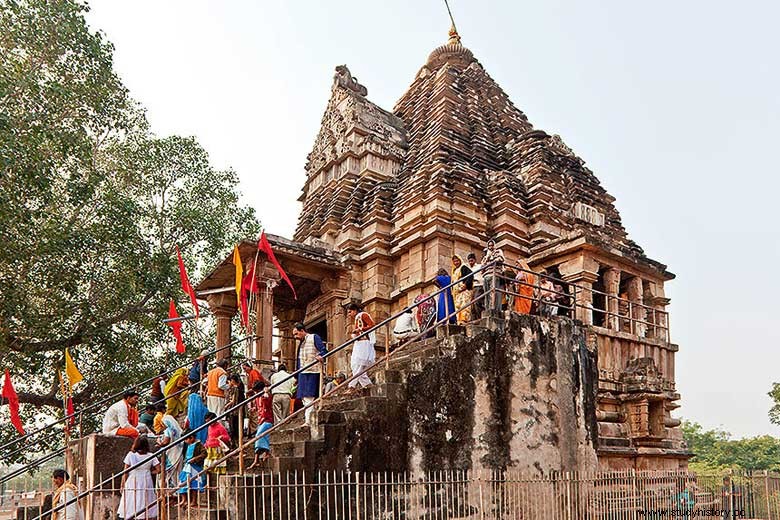
To understand modernism in thought, the richness of culture, the value of heritage, one must visit this temple. Even if you are not a God-fearing person, these captivated carvings and intricate sculptures are a perfect and unique combination to treat any spectator. One has to visit this place just to take a closer look at the stories conveyed by the walls and the beauty of the architecture.
How to visit the temple?
There are several tourist agencies offering this service. If you are planning a visit in February, a Khajuraho Dance Festival is held at the same time each year, which is performed against the backdrop of the Vishvanath Temple. This is similar to any other Indian festival held every year. While in this event you get a chance to visualize the aesthetics of Indian culture in one place.
The nearest transport options include "Khajuraho Airport", "Khajuraho Railway Station" and "Khajuraho Bus Stop". You can choose to fly there, and then it is only a few minutes drive from the airport to the temples. The bus stop is 1 km from the temples and there are bus stops running from other Indian states. But if you choose to commute by train, there are many trains connecting Khajuraho and other Indian cities. You can visit the government website of the state of Madhya Pradesh to check out more details.
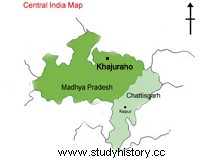
Choose your date, plan your trip, but never miss it, delight your eyes with this masterpiece of art and architecture that throbs with life, love, desire, passion and more.
